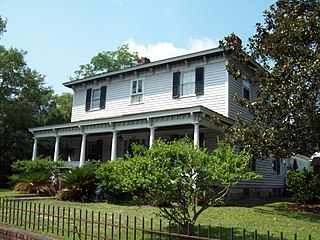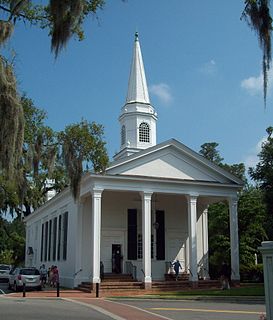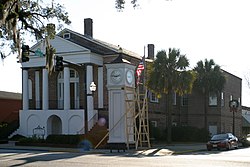
Conway is a city in Horry County, South Carolina, United States. The population was 24,849 at the 2020 census, up from 17,103 in 2010 census. It is the county seat of Horry County and is part of the Myrtle Beach metropolitan area. It is the home of Coastal Carolina University.

Robert Mills was a South Carolina architect known for designing both the first Washington Monument, located in Baltimore, Maryland, as well as the better known monument to the first president in the nation's capital, Washington, DC. He is sometimes said to be the first native-born American to be professionally trained as an architect. Charles Bulfinch of Boston perhaps has a clearer claim to this honor.

Atlantic Coast Line Railroad Depot is a historic train station located at Conway in Horry County, South Carolina. It was built in 1928 by the Atlantic Coast Line Railroad, and is a long, rectangular, one-story, gable-roofed, frame board-and-batten building. It features the wide overhanging eaves and is in the American Craftsman style.

Beaty-Little House is an historic home located at Conway in Horry County, South Carolina. It was built about 1855 and is a two-story, rectangular, central hall plan residence with a hipped roof and two interior brick chimneys. It features a full-width, hipped-roof porch across the front façade with freestanding Tuscan-influenced columns and an elaborately sawn balustrade.

Beaty-Spivey House is a historic home located at Conway in Horry County, South Carolina. It was built about 1870 and is a 1+1⁄2-story, cross-gable-roofed frame residence sheathed in weatherboard. It features a projecting gable with a half-story above and three-bay porch with four tapering, octagonal, freestanding posts and recessed porch at the first story.

J. W. Holliday Jr. House is a historic home located at Conway in Horry County, South Carolina. It was built in 1910, and is a two-story, rectangular, side-gable, frame, weatherboard-clad residence. It is dominated by a pedimented Beaux-Arts style portico with giant paired Ionic order columns.

C.P. Quattlebaum House is a historic home located at Conway in Horry County, South Carolina. It was built in 1807. It is a two-story, "T"-plan, cross-gable roofed, frame, weatherboard-clad residence. It features a two-story, projecting, polygonal bay and two-tiered wrap around porch with sawn brackets. Its owner, Cephas Perry Quattlebaum, served as Conway's first mayor and his office is located nearby, the C.P. Quattlebaum Office.

Paul Quattlebaum House is a historic home in Conway, Horry County, South Carolina, It was built about 1890 and is a 1½-story, gambrel-roofed, single-clad frame residence. It was remodeled in 1911 in the Dutch Colonial Revival style by Paul Quattlebaum to take its present form.

W. H. Winborne House is a historic home located at Conway in Horry County, South Carolina. It was built about 1925 and is a brick 1+1⁄2-story, rectangular plan, cross-gable-roofed American Craftsman-style residence. The façade features a broad peaked gable over an integral porch which wraps three sides.

Conway Methodist Church, 1898 and 1910 Sanctuaries, also known as First United Methodist Church, is a historic Methodist church located at Conway in Horry County, South Carolina. The 1898 sanctuary is a one-story, brick, cruciform, cross-gable roofed, Gothic Revival style building. It features Tudor arched stained glass lancet windows. The 1910 sanctuary is a Mission Revival style building and is a large one-story, front-gabled roof, stuccoed building. It features two square bell towers.

Kingston Presbyterian Church is a historic Presbyterian church located at Conway in Horry County, South Carolina. The sanctuary was built in 1858 and is an outstanding example of antebellum Greek Revival ecclesiastical design. The three-bay façade features a portico set on square columns with recessed panels and square pilasters. It was originally sheathed with weatherboard, but was covered in stucco in 1930 when a stuccoed brick addition was added to the rear. Also on the property is a Colonial Revival style brick educational building built in 1956. It is co-located with the Kingston Presbyterian Church Cemetery, listed on the National Register of Historic Places in 1986.

Burroughs School, also known as Burroughs Graded School, is a historic school located at Conway in Horry County, South Carolina. It was built in three phases between 1905 and 1923. The earliest portion of the building was built as an elementary school and has three main portions of eleven bays. It features a one-story, hip roof porch supported by six Ionic order columns with Scamozzi capitals. About 1915 a two-story hipped classroom wing was added and in 1923 four classrooms and an auditorium was added to the complex.

Kingston Presbyterian Church Cemetery is a historic cemetery located at Conway in Horry County, South Carolina. It contains fine examples of Victorian-era funerary art, especially those in the Beaty family plot. Portions of the cemetery site were first the old Kingston "burying ground", established about 1737, and burials continued until 1909. It is co-located with the Kingston Presbyterian Church, listed on the National Register of Historic Places in 2009.

Conway Post Office is a historic post office building located at Conway in Horry County, South Carolina. It was designed and built 1935–1936, and is one of a number of post offices in South Carolina designed by the Office of the Supervising Architect of the Treasury Department under Louis A. Simon. The building is in the Classical Revival style and is a one-story brick building that features an off-center entrance with large fanlight above. It was the first Federal post office built in the city of Conway until it was replaced by a new federal post office in 1977. In 1981, the renovated building was reopened as the Horry County Museum, which in 2014 moved to a new location in the Burroughs School.

The C.P. Quattlebaum Office is a historic law office building located at Conway in Horry County, South Carolina. It was built about 1860 as a residence. It was used as a law office for the firm Johnson, Johnson, and Quattlebaum after 1876 until 1929. It also housed the first bank in town; The Bank of Conway, from 1893 until 1899. It was moved to its present location about 1900.

Waccamaw River Memorial Bridge is a historic bridge located at Conway in Horry County, South Carolina.

Conway Downtown Historic District is a national historic district located at Conway in Horry County, South Carolina. It encompasses the historic commercial and governmental core of the city and includes 32 contributing buildings and one contributing structure. They collectively document the growth and development of Conway from about 1824 to about 1950. The majority of the contributing properties were constructed between about 1900 to about 1940. Located within the district is the Old Horry County Courthouse and the town clock. The Art Deco style Holliday Theater was built about 1940.

Conway Residential Historic District is a national historic district located at Conway in Horry County, South Carolina. It encompasses 125 contributing buildings and one contributing object. It includes a variety of quality 19th and 20th-century residential buildings, until about 1955. The residential buildings reflect a variety of popular architectural styles including Greek Revival, Carpenter Gothic Revival, Queen Anne, Italianate, and Tudor and Colonial Revival. The District also contains four apartment buildings, one school, a church, and a Confederate monument. Four properties in this historic district were previously listed: the Beaty-Little House, the Burroughs School, the J.W. Holliday Jr. House, and the W. H. Winborne House.

Waccamaw River Warehouse Historic District is a national historic district located at Conway in Horry County, South Carolina. It includes three contributing buildings: a steamer terminal, warehouse, and tobacco warehouse. These buildings illustrate the evolution of utilitarian structures at the end of the 19th century, documenting the shift from heavy-timber braced-frame structural members to smaller-member, balloon framing with multiple diagonal bracing and the use of a clerestory for additional light. They are the last extant warehouses in Conway associated with the commercial trade on the Waccamaw River.

Galivants Ferry Historic District is a national historic district located at Galivants Ferry in Horry County, South Carolina. It encompasses 28 contributing buildings that reflect the agricultural heritage of Galivants Ferry and of the larger Pee Dee region. Included are tenant farmer houses, storage barns, tobacco packhouses, curing barns, and sheds. The include the home of the Holliday family and a church that sits at the edge of a long stretch of tobacco fields on Pee Dee Road. Also included is a filling station along U.S. Route 501.
























